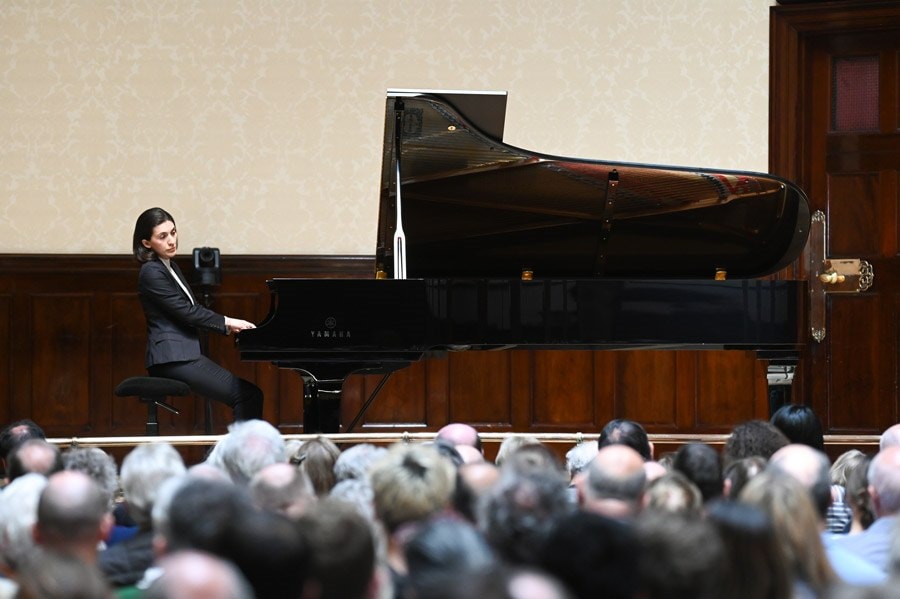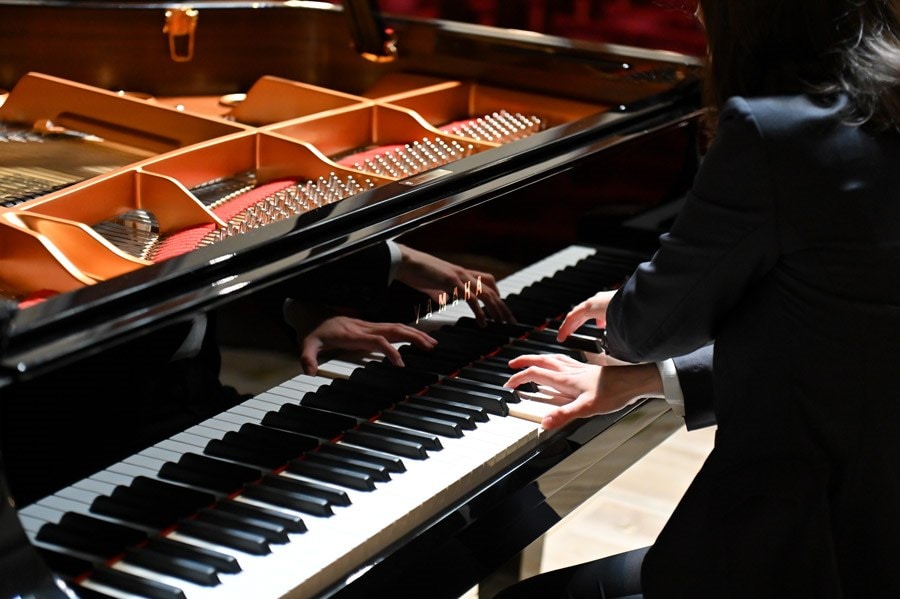Mariam Batsashvili performs with new CFX at Wigmore Hall
Yamaha's new CFX concert grand piano has already impressed some of the world's greatest pianists but on Monday 29 May it faced some of its sternest judges when it was played at the Wigmore Hall, London's prestigious recital venue, by Mariam Batsashvili, winner of the 10th Franz Liszt Piano Competition and a former BBC New Generation Artist, in a recital of works by Chopin, Schubert and Liszt, broadcast by BBC Radio Three.
The new instrument incorporates Yamaha's Unibody concept in which every component plays a part in conveying the performer's precise intentions. No single innovation explains this remarkable achievement; rather, it is a combination of science, experience and painstaking attention to detail on behalf of Yamaha's technicians and craftspeople, guided by performance feedback from top pianists.
In the wake of pianist Sir Stephen Hough's acclaimed tour with the instrument in the company of the Iceland Symphony Orchestra, Batsashvili's Wigmore Hall recital was an opportunity to hear the new CFX in a different but equally demanding context as it establishes its presence on the world's great stages.

The concert opened with Chopin's celebrated Ballade No.1 in G minor. Is there a passage in the repertoire more revealing of an artist's musicality and the quality of their instrument than its opening bars? An apparently simple melody played in both hands an octave apart rises majestically to a peak, heralding the arrival of the main theme. It's an arresting introduction to an emotionally charged work which, to succeed, requires a pianist with a supreme sense of musical line and a piano with the ability to convey the finest nuance. In Batsashvili and the new Yamaha CFX, the audience at the Wigmore Hall had both. With the merest touch, the CFX commanded their attention. Batsashvili exploited this quality not only in the opening bars of the Ballade but throughout the performance, her tone consistently warm and full bodied.
Chopin loved opera and prized a singing tone above everything else. Batsashvili relished achieving exactly this quality but speaking to me after the concert was quick to credit the CFX's contribution. "Incredibly, the piano sings by itself," she said. "Playing legato, so that there is no discernible gap between the notes, is key to achieving this effect. The CFX helps make this possible, even in the treble register where blending notes can be difficult. It's remarkable!"
Her performance of the Ballade had hinted at the CFX's expressive potential and in her next piece, 'Aprés une lecture du Dante' from Années de pèlerinage (Years of pilgrimage) by Franz Liszt, this potential was realised. Essentially a single-movement sonata inspired by Victor Hugo's poem of the same name, the work contrasts the torment of those in hell, symbolised by the first theme's use of the tritone or 'devil's interval', with the joy of those in heaven, illustrated by a chorale.
Under Batsashvili's fingers 'Hell' was dark and foreboding, the sense of mystery heightened by the CFX's rich timbre even when played softly. For the heavenly episodes Batsashvili enfolded the audience in a warm embrace of sound, topped by the CFX's captivating singing tone. Towards the end of the piece the notoriously tricky oscillations in both hands shimmered, illuminating the music in the sacred glow Liszt intended. The bass octaves that close the piece rolled like thunder.
Schubert's Impromptu in F minor, the third piece in Batsashvili's programme, is one of a group of four such works the composer wrote. It's a late-classical piece written on the cusp of the Romantic era characterised by the works of Chopin and Liszt, so is less heart-on-sleeve than the previous two pieces but no less emotionally charged.
Batsashvili's performance was beautifully judged; a hint of suppressed emotion below the surface calm. It was lyrical, too, especially so in the crossed hands duet early in the piece when Batsashvili held the audience spellbound, a moment broken only by the transition to the more declamatory-sounding exposition with which the work begins. For the return of the duet, Batsashvili's tone was even lighter and more silvery. During the soft chords that closed the piece, you could hear a pin drop.

For the final work in her recital, Batsashvili took us from the restrained drawing rooms of Vienna to a world stage dominated by Liszt. The Hungarian Rhapsody No.14 in F minor began life as a piece for piano and orchestra and was inspired by Romani Hungarian folk music. As a piece of musical theatre it has few rivals and, as Liszt intended, it is a showcase for pianist and piano alike.
Fortunately, both Batsashvili and new CFX were up to the task, the former deftly delivering perfectly voiced chords, cascading scales and glittering glissandi, the CFX responding in its customary way with torrents of hall-filling sound one moment and delicate lyricism the next. Batsashvili's performance rounded off a stunning recital and afterwards, reflecting on her on-stage partner, she said, "I'm very happy with the new CFX. In my opinion, Yamaha could not have done better."
